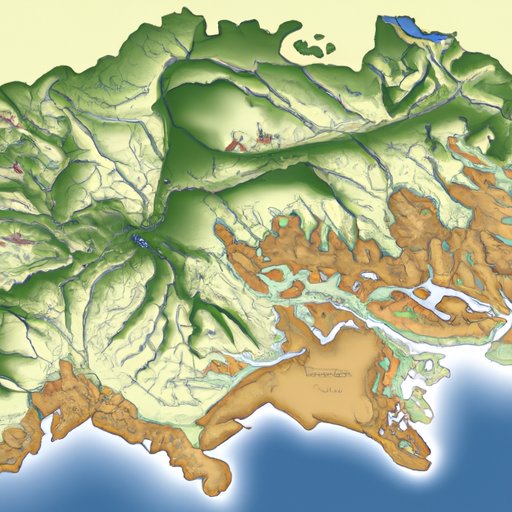
Introduction
There are countless ways to understand and experience our world, and one of the most important tools we have to do so is through maps. Specifically, physical maps help us grasp the natural landscape of our planet, from mountains and rivers to forests and oceans. In this article, we’ll explore what physical maps are, what they show, and how they can be used in various contexts.
Understanding Physical Maps: A Guide for All Ages
So what exactly is a physical map? Unlike political maps, which show borders and divisions between countries, physical maps are focused on the natural environment. They display physical features such as topography (the shape and elevation of the land), bodies of water, and natural resources. Often, physical maps use colors to denote different elevations or vegetation types, creating a visual representation of the physical world.
Physical maps can be used to gain a better understanding of a particular geographic region, or to compare different regions around the world. They can also be helpful for gaining insight into historical events that were shaped by geography (for example, locating the Himalayan Mountains on a physical map can help explain why China has been geographically isolated from much of the rest of the world throughout history).
Exploring the Geography of Our World: An Introduction to Physical Maps
There’s no doubt that physical maps can be fascinating and beautiful to look at, but they’re also important for understanding how geography affects daily life. Physical maps can help us understand how and why certain natural phenomena occur, such as climate zones and weather patterns.
Additionally, physical maps give us insight into how natural resources are distributed around the world. As we become increasingly aware of how important conservation is, it’s important to know where these resources are and how they can be protected. Finally, physical maps can help us identify how different regions are impacted by natural disasters, such as earthquakes and volcanic eruptions.
Topography, Natural Resources, and Weather: Discovering the Different Aspects of Physical Maps
As mentioned earlier, physical maps can be broken down into different categories according to what they display. Topographical maps are perhaps the most well-known type, and they show the elevation of different geographic features. Natural resource maps highlight things like oil and gas reserves, forests, and mineral deposits. Climate maps display average temperature and precipitation levels for different regions around the world.
All of these different maps can help us to better understand the impact of geography on our day-to-day lives. For example, understanding the topography of an area can help us predict flooding or identify areas that are at a higher risk of landslides. Similarly, understanding natural resource distribution can help us plan conservation efforts or identify areas that may face resource scarcities in the future.
Creating an Educational Experience at Home: Using Physical Maps to Teach Kids About Geography
Physical maps can be an incredible resource for parents and educators who want to help young learners develop an appreciation for the natural world. One great way to use physical maps in the classroom is by implementing hands-on activities that make map-reading more fun and engaging.
For example, you could have students create their own physical maps, using different colors and symbols to represent different types of landforms. Alternatively, you could have each student pick a different region of the world to research, then work together to create a giant physical map mural that shows all of the different regions they’ve studied.
The Science Behind Physical Maps: A Look into How They’re Made
For cartographers, the process of creating a physical map is a fascinating blend of art and science. There are several different technologies that are used in the map-making process, such as satellite imagery and computer modeling.
Additionally, cartographers use different methods to accurately represent the three-dimensional landscape of the world on a two-dimensional surface. One technique that is commonly used is called contouring, which involves drawing lines on the map that connect points of equal elevation. This creates a sense of depth and helps us understand how different landforms relate to one another.
A Visual Journey: Using Physical Maps to Plan Your Next Adventure
Physical maps can be more than just educational tools – they can also help us plan our next big adventure! Whether you’re planning a road trip or a hike in the wilderness, having a physical map on hand can be incredibly helpful for navigating unfamiliar terrain.
One great way to use physical maps is to look for hidden gems and off-the-beaten-path destinations that might not be well-known to the average traveler. For example, if you’re planning a trip to a national park, studying a physical map can help you identify areas that are less crowded or that offer more challenging terrain for hikers.
Conclusion
As we’ve seen, physical maps are incredibly useful tools for understanding the natural world. From exploring the geography of our planet to engaging kids in learning, physical maps can be valuable in many different contexts.




